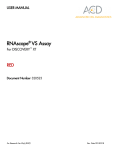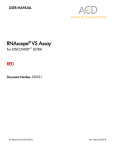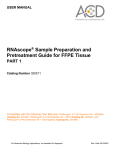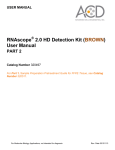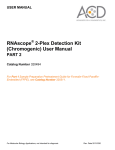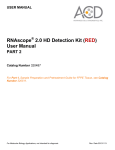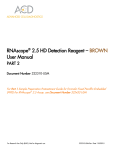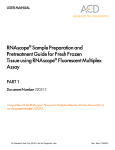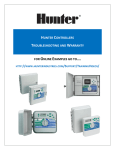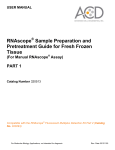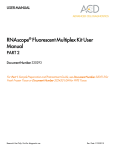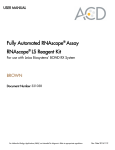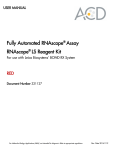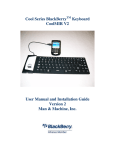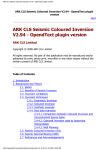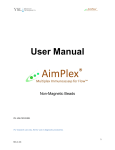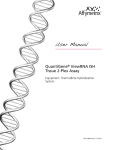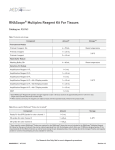Download RNAscope® VS Reagent Kit (BROWN) User Manual
Transcript
USER MANUAL RNAscope® VS Reagent Kit (BROWN) User Manual For Use with Ventana DISCOVERY™ XT System Catalog Number 320493 Complete guide: From Sample Pretreatment to RNAscope® Detection. For Molecular Biology Applications, not intended for diagnosis Rev. Date 20130628 For Molecular Biology Applications, not intended for diagnosis. Trademarks RNAscope® is a registered trademarks of Advanced Cell Diagnostics, Inc. VENTANA and DISCOVERY are trademarks of Roche. All other trademarks belong to their respective owners. Citing RNAscope® VS in Publications When describing a procedure for publication using this product, please refer to it as the RNAscope® VS Assay and cite: Wang F, Flanagan J, Su N, Wang L-C, Bui S, Nielson A, Wu X, Vo H-T, Ma X-J and Luo Y. RNAscope®: A Novel In Situ RNA Analysis Platform for Formalin-Fixed Paraffin-Embedded Tissues. J. Mol. Diagnostics, 2012, 14:22–29. Disclaimers Advanced Cell Diagnostics, Inc. reserves the right to change its products and services at any time to incorporate technological developments. This manual is subject to change without notice. Although this manual has been prepared with every precaution to ensure accuracy, Advanced Cell Diagnostics, Inc. assumes no liability for any errors, omissions, or for any damages resulting from the use of this information. Copyright © 2013. Advanced Cell Diagnostics, Inc. All rights reserved. Contents Chapter 1. Product Information .......................................................5 About this guide ............................................................................................... 5 Product description .......................................................................................... 5 Background.................................................................................................. 5 Overview ...................................................................................................... 5 Kit contents and storage .................................................................................. 6 RNAscope® VS Probes ............................................................................... 6 RNAscope® VS Reagents ........................................................................... 7 Required materials from Ventana™ Medical Systems ..................................... 8 Equipment and buffers ................................................................................ 9 User-supplied materials ............................................................................... 9 Chapter 2. Before You Begin .........................................................11 Important procedural guidelines .................................................................... 11 Chapter 3. Prepare and Pretreat Samples..................................... 13 Prepare FFPE sections ................................................................................. 13 Materials required ...................................................................................... 13 Fix the sample ........................................................................................... 13 Dehydrate, embed, and cut the sample .................................................... 13 Chapter 4. Semi-automated RNAscope® VS Assay ...................... 15 Workflow ........................................................................................................ 15 Prepare the materials .................................................................................... 16 Materials required ...................................................................................... 16 Prepare the instrument .............................................................................. 16 Prepare instrument reagents ..................................................................... 16 Prepare detergent ...................................................................................... 17 Prepare deparaffinization reagents ........................................................... 17 Prepare dehydrating reagents ................................................................... 17 Prepare 1X Pretreat 2 ................................................................................ 17 Create an instrument protocol ................................................................... 17 Print the labels ........................................................................................... 20 Manually pretreat the samples ...................................................................... 20 Materials required ...................................................................................... 20 Bake the slides .......................................................................................... 20 Deparaffinize FFPE sections ..................................................................... 21 Condition the slides ................................................................................... 21 Run the RNAscope® VS Assay ..................................................................... 22 Materials required ...................................................................................... 22 Loading the slides ...................................................................................... 22 Loading the reagents ................................................................................. 23 Start the run ............................................................................................... 23 Complete the run ....................................................................................... 23 RNAscope® VS Reagent Kit (BROWN) User Manual for use with DISCOVERY® XT 3 Wash the slides ......................................................................................... 23 Dehydrate the slides .................................................................................. 24 Mount the samples .................................................................................... 24 Chapter 5. Fully Automated RNAscope® VS Assay ...................... 25 Workflow ........................................................................................................ 25 Prepare the materials .................................................................................... 26 Materials required ...................................................................................... 26 Prepare the instrument .............................................................................. 26 Prepare instrument reagents ..................................................................... 26 Prepare detergent ...................................................................................... 27 Prepare dehydrating reagents ................................................................... 27 Create an instrument protocol ................................................................... 27 Print the labels ........................................................................................... 29 Run the RNAscope® VS Assay ..................................................................... 30 Materials required ...................................................................................... 30 Loading the slides ...................................................................................... 30 Loading the reagents ................................................................................. 30 Start the run ............................................................................................... 30 Complete the run ....................................................................................... 31 Wash the slides ......................................................................................... 31 Dehydrate the slides .................................................................................. 31 Mount the samples .................................................................................... 31 Chapter 6. Evaluate the results......................................................33 Scoring guidelines ......................................................................................... 33 Quantitative Image Analysis ...................................................................... 33 Troubleshooting ............................................................................................. 34 Control example ............................................................................................ 34 Appendix A. Recommended Guidelines ....................................... 35 Appendix B. Maintain the Instrument ............................................ 37 Flush the instrument ...................................................................................... 37 Purge and prime the system with clean distilled water ............................. 37 Purge and prime the system with fresh reagents ...................................... 38 Appendix C. Safety .........................................................................41 Chemical safety ............................................................................................. 41 Biological hazard safety................................................................................. 41 Documentation and support ..........................................................43 Obtaining MSDSs .......................................................................................... 43 Obtaining support .......................................................................................... 43 Contact information ....................................................................................... 43 Limited product warranty ............................................................................... 43 4 RNAscope® VS Reagent Kit (BROWN) User Manual for use with DISCOVERY® XT Chapter 1. Product Information 1 Before using this product, read and understand the information in Appendix C. Safety on page 41 in this document. IMPORTANT! We recommend reading the entire user manual before beginning any protocols. About this guide This user manual provides two versions of the RNAscope® VS Assay: • Chapter 4. Semi-automated RNAscope® VS Assay starting on page 15, for use with most sample types. • Chapter 5. Fully Automated RNAscope® VS Assay starting on page 25, for use with brain and spinal cord sections. Product description Background The RNAscope® Assays use a novel and proprietary method of in situ hybridization (ISH) to visualize single RNA molecules per cell in formalin-fixed, paraffin-embedded (FFPE) tissue mounted on slides. The assays are based on Advanced Cell Diagnostic’s patented signal amplification and background suppression technology, and can detect RNA molecules in archival samples and partially degraded specimens. The RNAscope® VS Assay allows users to automate the highly sensitive RNAscope® Assay using the Ventana™ DISCOVERY™ XT or ULTRA systems. Overview The RNAscope® VS Assay procedure is illustrated in Figure 1 on page 6 and can be completed on the instrument in ~8–10 hours. Starting with properly prepared samples, sections are first pretreated, and then RNA-specific probes are hybridized to target RNA. The signal is amplified using multiple steps, followed by hybridization to horseradish peroxidase (HRP)- or alkaline phosphatase (AP)-labeled probes and detection using a chromogenic substrate. Each single RNA transcript appears as a distinct dot of chromogen precipitate visible using a common bright-field microscope. RNAscope® VS Reagent Kit (BROWN) User Manual for use with DISCOVERY® XT 5 Figure 1 Procedure overview 1: Tissue section 2: Hybridize to target RNA Start with properly prepared sections and pretreat to allow access to target RNA. Hybridize gene-specific probe pairs to the target mRNA. 3: Amplify signal 4: Image Probes are hybridized to a cascade of signal amplification molecules, culminating in binding of HRP- or AP-labeled probes. The 2.0 Assay enhances signal further with additional amplification steps. Add DAB or Fast Red substrate to detect target RNA. Visualize target RNA using a standard bright field microscope. Kit contents and storage The RNAscope® VS Assay requires the RNAscope® VS Probes and the RNAscope® VS Reagents, available from Advanced Cell Diagnostics. RNAscope® VS Probes The RNAscope® VS Probes consist of the user-specified Target Probe and the Positive and Negative Control Probes. Visit www.acdbio.com/products/target-probes/searchproduct to find a gene-specific Target Probe. Visit www.acdbio.com/products/targetprobes/controls-housekeeping to order appropriate Control Probes. Each probe is sufficient for staining ~30 standard slides. The probes have a shelf life of six months from the shipment date when stored as indicated in the following table: Target Probes Reagent Cat. no. RNAscope® VS Target Probe – [species] Various – [gene] Content Quantity Probe targeting specific RNA 7 mL x 1 bottle Storage 4°C Control Probes Reagent 6 Cat. no. Content Quantity Storage RNAscope® VS Positive Control Probe – Various [species] – PPIB Probe targeting common housekeeping gene 7 mL x 1 bottle 4°C RNAscope® VS Negative Control Probe 310043 – DapB Probe targeting bacterial gene dapB 7 mL x 1 bottle 4°C RNAscope® VS Reagent Kit (BROWN) User Manual for use with DISCOVERY® XT RNAscope® VS Reagents The RNAscope® VS Reagents consist of the RNAscope® VS Reagent Kit, the RNAscope® VS Accessory Kit, and the RNAscope® VS Offline CC Kit. The kits provide enough reagents to stain ~60 standard slides. The reagents have a shelf life of six months from the shipment date when stored as indicated in the following table: RNAscope® VS Reagent Kit (Cat. no. 320600) Reagent Quantity Storage VS Pretreat A — Ready-To-Use (RTU) Protease A 14 mL x 1 bottle 4°C VS Pretreat B — RTU Protease B 14 mL x 1 bottle 4°C VS Amp 1 — RTU 14 mL x 1 bottle 4°C VS Amp 2 — RTU 14 mL x 1 bottle 4°C VS Amp 3 — RTU 14 mL x 1 bottle 4°C VS Amp 4 — RTU 14 mL x 1 bottle 4°C VS Amp 5–Brown — RTU 14 mL x 1 bottle 4°C VS Amp 6 –Brown — RTU 14 mL x 1 bottle 4°C VS Amp 7 — RTU 14 mL x 1 bottle 4°C RNAscope® VS Accessory Kit (Cat. no. 320630) Reagent VS Hematoxylin — RTU VS Blueing Reagent — RTU RNAscope® Reagent 10X Pretreat 2 Quantity Storage 7 mL x 1 bottle 4°C 7 mL x 1 bottle 4°C VS Offline CC Kit (Cat. no. 320043) Quantity 70 mL x 4 bottles Storage Room temperature (20– 25°C) IMPORTANT! Do not substitute the reagent components of the RNAscope® VS Reagent Kit with those of other RNAscope® Reagent Kits, even those having the same name. RNAscope® VS Reagent Kit (BROWN) User Manual for use with DISCOVERY® XT 7 Required materials from Ventana™ Medical Systems The RNAscope® VS Assay requires specific materials and equipment available only from Ventana™ Medical Systems. Probe Dispensers (Cat. no. 960-761 to 960-780) Component Probes 1–20 dispensers — fill dispensers with RNAscope® VS Probes. Use up to 20 probes at a time. Storage Room temperature (20–25°C) mRNA Pretreatment Kit (Cat. no. 760-223) Component Storage mRNA Pretreat A dispenser — fill dispenser with Pretreat A Room temperature (20–25°C) mRNA Pretreat B dispenser — fill dispenser with Pretreat B Room temperature (20–25°C) mRNA Probe Amplification Kit (Cat. no. 760-222) Component Storage mRNA Amp 1 dispenser — fill dispenser with Amp 1 Room temperature (20–25°C) mRNA Amp 2 dispenser — fill dispenser with Amp 2 Room temperature (20–25°C) mRNA Amp 3 dispenser — fill dispenser with Amp 3 Room temperature (20–25°C) mRNA Amp 4 dispenser — fill dispenser with Amp 4 Room temperature (20–25°C) mRNA Amp 5 dispenser — fill dispenser with Amp 5 Room temperature (20–25°C) mRNA Amp 6 dispenser — fill dispenser with Amp 6 Room temperature (20–25°C) mRNA Amp 7 dispenser — fill dispenser with Amp 7 Room temperature (20–25°C) mRNA DAB Detection Kit (Cat. no. 760-224) Component Storage mRNA Inhibitor-prefilled 4°C mRNA DAB dispenser-prefilled 4°C mRNA H2O2 dispenser-prefilled 4°C mRNA Copper dispenser-prefilled 4°C Generic dispensers (Cat. no. 771-741 and 771-742) Component Storage Counterstain 1 dispenser — fill dispenser with Hematoxylin Room temperature (20–25°C) Counterstain 2 dispenser — fill dispenser with blueing reagent Room temperature (20–25°C) mRNA DAB, Amplification & Pretreatment Kit (Cat. No. 760-225) Component 8 Storage mRNA DAB Detection Kit (Cat. No. 760-224) 4°C mRNA Pretreatment Kit (Cat. no. 760-223) Room temperature (20–25°C) mRNA Probe Amplification Kit (Cat. no. 760-222) Room temperature (20–25°C) RNAscope® VS Reagent Kit (BROWN) User Manual for use with DISCOVERY® XT Equipment and buffers Component DISCOVERY™ Cat. no. XT — automated slide stainer F-DISXT-750000 EZPrep Buffer 950-100 LCS Buffer 650-010 RiboWash Buffer 760-105 RiboCC Buffer — used for automated cell conditioning (CC2) 760-107 Reaction Buffer 950-300 1X SSC Wash (in Option Bottle) 950-210 User-supplied materials IMPORTANT! Do not substitute other materials for the SuperFrost® Plus Slides listed in the following table. Description SuperFrost® Plus Slides (required) Supplier Cat. no. 12-550-15 Fisher Scientific Scientific/MLS* 100% ethanol American Master Tech Tissue-Tek® Vertical 24 Slide Rack American Master Tech Scientific/MLS ALREAGAL LWSRA24 Tissue-Tek® Staining Dish (6 required) American Master Tech Scientific/MLS LWT4457EA Tissue-Tek® Clearing Agent Dish, xylene resistant (3 required) American Master Tech Scientific/MLS Cover Glass 24 x 50 mm Fisher Scientific/MLS 12--545-F Distilled water MLS — Dawn detergent MLS — Fume hood MLS — Glass beaker (1 or 2 L) MLS — Hot plate Fisher Scientific/MLS 11-300-49SHP LWT4456EA * Major Laboratory Supplier in North America. For other regions, please check Catalog Numbers with your local lab supplier. RNAscope® VS Reagent Kit (BROWN) User Manual for use with DISCOVERY® XT 9 10 RNAscope® VS Reagent Kit (BROWN) User Manual for use with DISCOVERY® XT 2 Chapter 2. Before You Begin Prior to running the RNAscope® VS Assay on your samples for the first time, we recommend that you: • Be familiar with the Ventana™ DISCOVERY™ XT system. Refer to the Ventana™ System User Manual. • View the video demonstrations available at www.acdbio.com/support/online-trainingvideos. • Run the assay on FFPE RNAscope® Control Slides (Cat. no. 310045 for Human control slide, Hela; Catalog No. 310023 for Mouse control slide, 3T3) using the Positive and Negative Control Probes. Important procedural guidelines • Start with properly fixed and prepared sections. Refer to Chapter 3. Prepare and Pretreat Samples on page 13 for preparation of FFPE slides. For preparation of other sample types, contact [email protected]. • Optimize pretreatment conditions for your sample. Refer to Appendix A. Recommended Guidelines on page 35 for pretreatment conditions. • Regularly maintain and clean your automated staining instrument. • Always run positive and negative control probes on your sample to assess sample RNA quality and optimal permeabilization. • Do not substitute required materials. Assay has been validated with these materials only. • Follow the protocol exactly for best results. • Do not let your sections dry out during the procedure. • Use good laboratory practices and follow all necessary safety procedures. Refer to Appendix C. Safety on page 41 for more information. RNAscope® VS Reagent Kit (BROWN) User Manual for use with DISCOVERY® XT 11 12 RNAscope® VS Reagent Kit (BROWN) User Manual for use with DISCOVERY® XT Chapter 3. Prepare and Pretreat Samples 3 Formalin-fixed, paraffin-embedded (FFPE) sample preparation and pretreatment are described in the following protocols. IMPORTANT! We highly recommend following these guidelines. We cannot guarantee assay results with other preparation methods. For suboptimally treated samples, follow the recommended guidelines in Appendix A. Recommended Guidelines on page 35. Prepare FFPE sections Materials required • 10% neutral buffered formalin (NBF) • 1X PBS • Paraffin wax • 100% ethanol, ACS grade or equivalent • Xylene • Microtome • Water bath • SuperFrost® Plus slides Fix the sample 1. Remove sample and CUT 3–4 mm pieces prior to fixing. CAUTION! Handle biological specimens appropriately. 2. Fix sample in FRESH 10% NBF for 16–32 HOURS at ROOM TEMPERATURE. Fixation time will vary depending on tissue type. IMPORTANT! Under-fixation will result in significant signal loss when performing the RNAscope® Assay. Dehydrate, embed, and cut the sample IMPORTANT! Use fresh reagents. 1. WASH sample with 1X PBS. 2. DEHYDRATE sample using a standard ETHANOL series, followed by XYLENE. 3. EMBED sample in PARAFFIN using standard procedures. RNAscope® VS Reagent Kit (BROWN) User Manual for use with DISCOVERY® XT 13 Note: Embedded samples may be stored at room temperature for years. 4. Trim paraffin blocks as needed, and CUT embedded tissue into 5 +/- 1 μm sections using a microtome. 5. Place paraffin ribbon in a 40–45°C water bath, and MOUNT sections on SUPERFROST® PLUS SLIDES. IMPORTANT! Do not mount more than one section per slide. Place sections in the center of the slide. 6. AIR DRY slides OVERNIGHT at ROOM TEMPERATURE. Do NOT bake slides unless they will be used for RNAscope within 1 week. OPTIONAL STOPPING POINT. Use sectioned tissue within 3 months. Store sections with dessicants at room temperature. 14 RNAscope® VS Reagent Kit (BROWN) User Manual for use with DISCOVERY® XT 4 Chapter 4. Semi-automated RNAscope® VS Assay Most sample types require manual pretreatment prior to running the automated RNAscope® VS Assay. For brain and spinal cord sections, you may fully automate manual pretreatment steps. See Chapter 5. Fully Automated RNAscope® Assay on page 25. Workflow Prepare the materials Bake the slides 1 hour Deparaffinize FFPE tissue ~20 minutes Condition the slides ~20–45 minutes Run the RNASCOPE® VS Assay ~8 hours RNAscope® VS Reagent Kit (BROWN) User Manual for use with DISCOVERY® XT 15 Prepare the materials Materials can be prepared ahead of time or while baking the slides, unless otherwise stated. See Bake the slides on page 20. Materials required Materials provided by Advanced Cell Diagnostics • VS Target Probe Materials provided by Ventana™ Medical Systems Other materials and equipment • VS Positive Control Probe • DISCOVERY™ XT — automated slide stainer • VS Negative Control Probe • EZPrep Buffer • Pretreat 2 • LCS Buffer • Paper towels or absorbent paper • VS Pretreat A • RiboWash Buffer • Aluminum foil • VS Pretreat B • Reaction Buffer • Thermometer • VS Amp 1 • 1X SSC (Option Bottle) • Forceps, large • Distilled water • Glass beaker (1 or 2 L) • VS Amp 2 • Probe dispensers • Hot plate • VS Amp 3 • mRNA Pretreatment Kit • Dawn detergent • VS Amp 4 • mRNA Probe Amplification Kit • Fume hood • VS Amp 5–Brown • mRNA DAB Detection Kit • Xylene • VS Amp 6–Brown • Generic dispensers • 100% ethanol • VS Amp 7 • Tissue-Tek® Staining Dish (6) • VS Hematoxylin • Tissue-Tek® Clearing Agent Dish, xylene-resistant (4) • VS Blueing reagent • Tissue-Tek® Vertical 24 Slide Rack • Cytoseal XYL xylene-based • Cover Glass, 24 mm x 50 mm • Laboratory tissue paper Prepare the instrument • If the instrument has not been used for ≥1 week, follow the guidelines for instrument maintenance in Appendix B on page 37. • If your instrument has been used recently, run the “Prime-XT” protocol two times to clear the fluid lines before setting up the experiment. Refer to the Ventana™ System User Manual and Appendix B for details. Prepare instrument reagents Register new reagent kits using the wand that comes with the instrument. 1. In reverse order from AMP 7 to AMP 1, TRANSFER the entire volume of each RNAscope® VS Reagent Kit component into the correspondingly labeled DISPENSER. 2. TRANSFER the rest of the RNASCOPE® VS REAGENTS to the correspondingly labeled DISPENSERS. IMPORTANT! Avoid cross contamination between reagents. 16 RNAscope® VS Reagent Kit (BROWN) User Manual for use with DISCOVERY® XT 3. Follow the dispenser product insert instructions to properly prime and handle the dispensers. 4. PRESS the dispenser CAPS down TIGHTLY. Note: Store tightly capped dispensers at 4°C when not in use. 5. CHECK SOLUTION LEVELS: EZprep, Ribowash, RiboCC, Reaction, LCS Buffer, and 1X SSC. REFILL if they are less than half full. IMPORTANT! Use reagents that have not expired. 6. EMPTY the WASTE bottle if needed. Prepare detergent 1. PREPARE 200 mL of DILUTED DAWN DETERGENT by adding 4–5 mL Dawn detergent to 200 mL distilled water in a container with a cap. 2. MIX WELL by inverting the container 4–5 times. 3. Add diluted detergent to a Tissue-Tek® Staining Dish. Note: Store diluted detergent at room temperature. Prepare deparaffinization reagents • In a fume hood, fill TWO Clearing Agent DISHES with ~200 mL FRESH XYLENE. • In a fume hood, fill TWO Staining DISHES with ~200 mL FRESH 100% ETHANOL. Note: Ensure all containers remain covered. Prepare dehydrating reagents IMPORTANT! Do not reuse deparaffinization reagents. • In a fume hood, fill TWO Clearing Agent DISHES with ~200 mL FRESH XYLENE. • In a fume hood, fill THREE Staining DISHES with ~200 mL FRESH 100% ETHANOL. Note: Ensure all containers remain covered. Prepare 1X Pretreat 2 1. Prepare 1X PRETREAT 2 while FFPE slides are baking at 60°C, or the following day if you choose the optional stopping point on page 14. 1X Pretreat 2 is used in manual cell conditioning (CC). 2. Prepare 700 mL of FRESH 1X PRETREAT 2 by adding 630 mL distilled water to 1 bottle (70 mL) 10X Pretreat 2 solution in the beaker. 3. MIX WELL and cover the beaker with foil. Create an instrument protocol 1. OPEN the NexES SOFTWARE and CLICK on the “PROTOCOL” BUTTON. 2. CLICK on “CREATE/EDIT PROTOCOL”, go to the “Procedure” drop down menu and SELECT “mRNA DAB DXT 2.0”. Main protocol steps appear as shown: RNAscope® VS Reagent Kit (BROWN) User Manual for use with DISCOVERY® XT 17 3. After selecting the main protocol steps, drop down menus become available. SELECT the appropriate protocol STEPS by clicking on the associated check boxes as shown: 18 RNAscope® VS Reagent Kit (BROWN) User Manual for use with DISCOVERY® XT 4. SELECT the appropriate assay CONDITIONS from the drop down menus according to the following table: Tissue type Pretreatment #2 Pretreatment #3 Brain and spinal cord 12 minutes 12 minutes Breast cancer 12 minutes 12 minutes Cell lines 12 minutes 12 minutes Colon 12 minutes 12 minutes GI tract 12 minutes 12 minutes Head and neck cancer 12 minutes 12 minutes Heart 12 minutes 12 minutes Kidney 12 minutes 12 minutes Liver 12 minutes 12 minutes Lung 12 minutes 12 minutes Lymphoma 8 minutes 8 minutes Placenta 12 minutes 12 minutes Prostate 12 minutes 12 minutes Skin 12 minutes 12 minutes Stomach 12 minutes 12 minutes Thymus 8 minutes 8 minutes Tonsil 8 minutes 8 minutes Xenografts derived from cell lines 12 minutes 12 minutes Xenografts derived from primary tumor 12 minutes 12 minutes 5. CLICK “SAVE AS”, then SELECT a protocol NUMBER from the drop down menu and CHOOSE a protocol NAME for each probe. CLICK “SAVE”. RNAscope® VS Reagent Kit (BROWN) User Manual for use with DISCOVERY® XT 19 6. CLICK “CLOSE” to go back to the main screen. 7. Assign a PROBE NUMBER from the list to each probe of interest. For each probe selected, ASSIGN a PROTOCOL. Print the labels 1. SELECT the PRINT LABEL icon from the bottom of the home page screen. 2. SELECT your preferred TEMPLATE or CREATE new TEMPLATE. To create a new template, refer to the Ventana™ System User Manual for details. 3. SELECT the PROTOCOL you created for the RNAscope® VS Assay. 4. CLICK on “PROTOCOL” to ADD and PRINT the label. Manually pretreat the samples Materials required Materials provided by the RNAscope® VS Reagents • Pretreat 2 Other materials and equipment • Drying oven • FFPE slides • Tissue-Tek® Vertical 24 Slide Rack • Distilled water • Fume hood • Xylene • 100% ethanol • Tissue-Tek® Clearing Agent Dish (2) • Tissue-Tek® Staining Dish (2) • Glass beaker (1 or 2 L) • Paper towel or absorbent paper • Hot plate • Aluminum foil • Forceps, large • Thermometer Bake the slides 1. Bake slides in a dry oven for 1 HOUR at 60°C. STOPPING POINT Use immediately or store at room temperature with dessicants for ≤1 week. Prolonged storage may degrade sample RNA. 2. If you continue, prepare the materials for the following protocols while the slides are baking: Deparaffinize FFPE sections in the next section, Condition the slides on page 21, and Run the RNAscope® VS Assay on page 25. See Prepare the materials on page 16. 20 RNAscope® VS Reagent Kit (BROWN) User Manual for use with DISCOVERY® XT Deparaffinize FFPE sections IMPORTANT! If you have not done so already, create a protocol for your instrument and print slide labels during this procedure. See pages 17–19. 1. Place slides in a Tissue-Tek® Slide Rack and submerge in the first xylene-containing Clearing Agent Dish in the fume hood. 2. Incubate the slides in XYLENE for 5 MINUTES at ROOM TEMPERATURE. Agitate 3. 4. 5. 6. 7. 8. 9. the slides by occasionally lifting the slide rack up and down in the Clearing Agent Dish. Remove the slide rack from the first xylene-containing dish and immediately place in the second xylene-containing Clearing Agent Dish in the fume hood. REPEAT STEP 2. Remove the slide rack from the second xylene-containing dish and immediately place in the Staining Dish containing 100% ethanol. Incubate the slides in 100% ETHANOL for 1 MINUTE at ROOM TEMPERATURE with agitation. REPEAT STEP 6 with FRESH 100% ETHANOL. Remove the slides from the rack, and place on absorbent paper with the section faceup. AIR DRY for 5 MINUTES at ROOM TEMPERATURE. While slides are drying, PLACE printed LABELS on the slides. IMPORTANT! Labels must be in place prior to the next section. 10. INSERT the SLIDES into a Tissue-Tek® Slide RACK and proceed to CONDITION THE SLIDES. Condition the slides 1. Begin heating 1X Pretreat 2 while FFPE slides are baking at 60°C or during the previous section. IMPORTANT! Do not boil 1X Pretreat 2 more than 30 minutes before use. 2. HEAT 1X PRETREAT 2 to 95–104°C: a. Place the beaker containing 1X Pretreat 2 on the hot plate. Cover the beaker with foil and turn the hot plate on high for 10–15 minutes. b. Once 1X PRETREAT 2 reaches a slow boil (98–104°C), turn the hot plate to a lower setting to maintain the correct temperature. Check the temperature with a thermometer. 3. With a pair of forceps very slowly submerge the slide rack containing the slides into the boiling 1X PRETREAT 2 solution. Cover the beaker with foil and BOIL the slides for the amount of time specified in the following table: Tissue type Treatment time Brain and spinal cord* 15 minutes Breast cancer 15 minutes Cell lines 10 minutes Colon 15 minutes GI tract 15 minutes Head and neck cancer 15 minutes RNAscope® VS Reagent Kit (BROWN) User Manual for use with DISCOVERY® XT 21 Tissue type Treatment time Heart 15 minutes Kidney 15 minutes Liver 30 minutes Lung 15 minutes Lymphoma 10 minutes Placenta 15 minutes Prostate 15 minutes Skin 15 minutes Stomach 15 minutes Thymus 10 minutes Tonsil 10 minutes Xenografts derived from cell lines 7 minutes Xenografts derived from primary tumor 15 minutes 4. 5. 6. 7. * This procedure can be automated for these tissue types. See page 25. Use the forceps to immediately transfer the hot slide rack from the 1X Pretreat 2 to the Staining dish containing DISTILLED WATER. Do not let the slides cool in Pretreat 2. WASH slides 3–5 TIMES by moving the Tissue-Tek® Slide Rack up and down in the DISTILLED WATER. REPEAT STEP 4 with FRESH DISTILLED WATER. Proceed to LOADING THE SLIDES. Run the RNAscope® VS Assay Materials required • Prepared instrument reagents • Distilled water • Paper towels or absorbent paper • Dawn detergent • Fume hood • Xylene • 100% ethanol • Tissue-Tek® Staining Dish (3) • Tissue-Tek® Clearing Agent Dish, xylene-resistant (2) • Tissue-Tek® Vertical 24 Slide Rack • Cytoseal XYL xylene-based • Cover Glass, 24 mm x 50 mm Loading the slides IMPORTANT! Prior to loading the slides, ensure heater pads are completely dry. Wipe off any solution using laboratory tissue paper. 22 RNAscope® VS Reagent Kit (BROWN) User Manual for use with DISCOVERY® XT 1. Following the “CONDITION THE SLIDES” step on page 21, LOAD each SLIDE onto a HEATER PAD with the LABEL FACING AWAY from you. Ensure that the slides sit securely on the pads. 2. COVER each SLIDE with DISTILLED WATER. Note: Avoid pouring distilled water directly on the sections. Loading the reagents 1. REMOVE the nozzle CAPS of the filled dispensers and place them on their holders. 2. If needed, REMOVE any AIR BUBBLES at the nozzle tips by squeezing out one drop of reagent. 3. LOAD DISPENSERS onto the reagent RACKS. 4. REMOVE the yellow LOCKING RING from the dispensers in the prefilled mRNA DAB DETECTION KIT. Refer to the instructions provided by Ventana™ Medical Systems. 5. LOAD the reagent RACKS onto the reagent CAROUSEL. Start the run 1. CLICK the “RUN” button 2. Follow the instructions on the instrument screen. SELECT the "REAGENT/REAGENT TRAY LOADED", and "REAGENT CAPS REMOVED"check boxes. 3. ENTER the NUMBER of SLIDES. 4. CLICK the “RUNNING” button. Automated assay will finish in ~8 hours. IMPORTANT! Before leaving the instrument unattended, ensure all reagents and slides are successfully registered and the instrument is running. Complete the run 1. After the RUN is COMPLETE, place nozzle CAPS back on the DISPENSERS. 2. STORE reagent RACKS at 4°C until next use. Wash the slides Add 200 mL diluted DETERGENT to a Tissue-Tek® Staining DISH. SUBMERGE a Tissue-Tek® Slide RACK into the Staining DISH. OPEN the instrument SLIDE TRAY and UNLOAD SLIDES. DECANT SOLUTION on the slides into the slide tray, then immediately LOAD SLIDES into the Tissue-Tek® Slide RACK submerged in detergent. 5. RINSE OIL off the slides by moving the slide rack up and down in the dish 10 TIMES. 6. REPLACE the detergent with DISTILLED WATER and RINSE SLIDES by moving the slide rack up and down 10 TIMES. 7. REPEAT STEP 6 3–5 TIMES. 1. 2. 3. 4. RNAscope® VS Reagent Kit (BROWN) User Manual for use with DISCOVERY® XT 23 Dehydrate the slides 1. Move the Tissue-Tek® Slide rack into the first Staining Dish containing 100% 2. 3. 4. 5. ETHANOL in the fume hood for 2 MINUTES. Agitate the slides by occasionally lifting the slide rack up and down. Move the Tissue-Tek® Slide rack into the second Staining Dish containing 100% ETHANOL for 2 MINUTES with occasional agitation. Move the Tissue-Tek® Slide rack into the third Staining Dish containing 100% ETHANOL for 2 MINUTES with occasional agitation. Move the Tissue-Tek® Slide rack into the Staining Dish containing XYLENE for 1 MINUTE with occasional agitation. Move the Tissue-Tek® Slide rack RACK into the Staining Dish containing XYLENE for 1 MINUTE with occasional agitation. Mount the samples 1. Remove the slides from the Tissue-Tek® Slide Rack and lay flat with the sections facing up in the fume hood. 2. Mount one slide at a time by adding 1–2 DROPS of CYTOSEAL or other xylene-based mounting medium to each slide and carefully placing a 24 mm x 50 mm COVERSLIP over the section. Avoid trapping air bubbles. 3. AIR DRY slides for 5 MINUTES. 4. Proceed to Chapter 6. Evaluate the results on page 33. 24 RNAscope® VS Reagent Kit (BROWN) User Manual for use with DISCOVERY® XT 5 Chapter 5. Fully Automated RNAscope® VS Assay Use this protocol for brain and spinal cord sections. The Fully Automated RNAscope® VS Assay shares many of the same steps as the Semi-automated RNAscope® VS Assay. Do not perform the manual pretreatment steps. IMPORTANT! Run the assay on FFPE RNAscope® Control Slides (Cat. no. 310045 for Human control slide, Hela; Catalog No. 310023 for Mouse control slide, 3T3) using the Positive and Negative Control Probes. Workflow Prepare the materials Run the RNASCOPE® VS Assay ~10 hours RNAscope® VS Reagent Kit (BROWN) User Manual for use with DISCOVERY® XT 25 Prepare the materials Materials can be prepared ahead of time, unless otherwise stated. Materials required Materials provided by Advanced Cell Diagnostics Materials provided by Ventana™ Medical Systems • DISCOVERY™ XT — automated slide stainer • VS Target Probe • VS Positive Control Probe • VS Negative Control Probe • Pretreat 2 • VS Pretreat A Other materials and equipment • Distilled water • EZPrep Buffer • Paper towels or absorbent paper • LCS Buffer • Dawn detergent • RiboWash Buffer • Fume hood • RiboCC Buffer — used in the fully • automated assay (CC2) • • Reaction Buffer • • 1X SSC (Option Bottle) • • Probe dispensers • VS Pretreat B • VS Amp 1 • VS Amp 2 • VS Amp 3 • VS Amp 4 • mRNA Pretreatment Kit • VS Amp 5–Brown • mRNA Probe Amplification Kit • VS Amp 6–Brown • mRNA DAB Detection Kit • VS Amp 7 • Generic dispensers • VS Hematoxylin Xylene 100% ethanol Tissue-Tek® Staining Dish (3) Tissue-Tek® Clearing Agent Dish, xylene-resistant (2) • Tissue-Tek® Vertical 24 Slide Rack • Cytoseal XYL xylene-based • Cover Glass, 24 mm x 50 mm • Laboratory tissue paper • VS Blueing reagent Prepare the instrument • If the instrument has not been used for ≥1 week, follow the guidelines for instrument maintenance in Appendix B on page 37. • If your instrument has been used recently, run the “Prime-XT” protocol two times to clear the fluid lines before setting up the experiment. Refer to the Ventana™ System User Manual and Appendix B for details. Prepare instrument reagents Register new reagent kits using the wand that comes with the instrument. 1. In reverse order from AMP 7 to AMP 1, TRANSFER the entire volume of each RNAscope® VS FFPE Reagent Kit component into the correspondingly labeled DISPENSER. 2. TRANSFER the rest of the RNASCOPE® VS REAGENTS to the correspondingly labeled DISPENSERS. IMPORTANT! Avoid cross contamination between reagents. 3. Follow the dispenser product insert instructions to properly prime and handle the dispensers. 4. PRESS the dispenser CAPS down TIGHTLY. Note: Store tightly capped dispensers at 4°C when not in use. 26 RNAscope® VS Reagent Kit (BROWN) User Manual for use with DISCOVERY® XT 5. CHECK SOLUTION LEVELS: EZprep, Ribowash, RiboCC, Reaction, LCS Buffer, and 1X SSC. REFILL if they are less than half full. IMPORTANT! Use reagents that have not expired. 6. EMPTY the WASTE bottle if needed. Prepare detergent 1. PREPARE 200 mL of DILUTED DAWN DETERGENT: a. Add 4–5 mL Dawn detergent to 200 mL distilled water in a container with a cap. b. Mix well by inverting the container 4–5 times. c. Add diluted detergent to a Tissue-Tek® Staining Dish. Note: Store diluted detergent at room temperature. Prepare dehydrating reagents IMPORTANT! Do not reuse deparaffinization reagents. • In a fume hood, fill TWO Clearing Agent DISHES with ~200 mL FRESH XYLENE. • In a fume hood, fill THREE Staining DISHES with ~200 mL FRESH 100% ETHANOL. Note: Ensure all containers remain covered. Create an instrument protocol 1. OPEN the NexES SOFTWARE and CLICK on the “PROTOCOL” BUTTON. 2. CLICK on “CREATE/EDIT PROTOCOL”, go to the “Procedure” drop down menu and SELECT “mRNA DAB DXT 2.0”. Main protocol steps appear as shown: RNAscope® VS Reagent Kit (BROWN) User Manual for use with DISCOVERY® XT 27 3. After selecting the main protocol steps, drop down menus become available. SELECT the appropriate protocol STEPS by clicking on the associated check boxes as shown: 28 RNAscope® VS Reagent Kit (BROWN) User Manual for use with DISCOVERY® XT 4. SELECT the appropriate assay CONDITIONS from the drop down menus according to the following table: Tissue type Brain and spinal cord Automated cell conditioning 100°C, mild CC2 Pretreatment #2 12 minutes Pretreatment #3 12 minutes 5. CLICK “SAVE AS”, then SELECT a protocol NUMBER from the drop down menu and CHOOSE a protocol NAME for each probe. CLICK “SAVE”. 6. CLICK “CLOSE” to go back to the main screen. 7. Assign a PROBE NUMBER from the list to each probe of interest. For each probe selected, ASSIGN a PROTOCOL. Print the labels 1. SELECT the PRINT LABEL icon from the bottom of the home page screen. 2. SELECT your preferred TEMPLATE or CREATE new TEMPLATE. To create a new template, refer to the Ventana™ System User Manual for details. 3. SELECT the PROTOCOL you created for the RNAscope® VS Assay. 4. CLICK on “PROTOCOL” to ADD and PRINT the LABEL. 5. PROCEED to LOADING THE SLIDES on page 30. RNAscope® VS Reagent Kit (BROWN) User Manual for use with DISCOVERY® XT 29 Run the RNAscope® VS Assay Materials required • Prepared instrument reagents • Distilled water • Paper towels or absorbent paper • Dawn detergent • Fume hood • Xylene • 100% ethanol • Tissue-Tek® Staining Dish (3) • Tissue-Tek® Clearing Agent Dish, xylene-resistant (2) • Tissue-Tek® Vertical 24 Slide Rack • Cytoseal XYL xylene-based • Cover Glass, 24 mm x 50 mm Loading the slides IMPORTANT! Prior to loading the slides, ensure heater pads are completely dry. Wipe off any solution using laboratory tissue paper. 1. LOAD each SLIDE onto a HEATER PAD with the LABEL FACING AWAY from you. Ensure that the slides sit securely on the pads. 2. COVER each SLIDE with DISTILLED WATER. Note: Avoid pouring distilled water directly on the sections. Loading the reagents 1. REMOVE the nozzle CAPS of the filled dispensers and place them on their holders. 2. If needed, REMOVE any AIR BUBBLES at the nozzle tips by squeezing out one drop of reagent. 3. LOAD DISPENSERS onto the reagent RACKS. 4. REMOVE the yellow LOCKING RING from the dispensers in the prefilled mRNA DAB DETECTION KIT. Refer to the instructions provided by Ventana™ Medical Systems. 5. LOAD the reagent RACKS onto the reagent CAROUSEL. Start the run 1. CLICK the “RUN” button. 2. Follow the instructions on the instrument screen. SELECT the "REAGENT/REAGENT TRAY LOADED", and "REAGENT CAPS REMOVED"check boxes. 3. ENTER the NUMBER of SLIDES. 4. CLICK the “RUNNING” button. Automated assay will finish in ~8 hours. IMPORTANT! Before leaving the instrument unattended, ensure all reagents and slides are successfully registered and the instrument is running. 30 RNAscope® VS Reagent Kit (BROWN) User Manual for use with DISCOVERY® XT Complete the run 1. After the RUN is COMPLETE, PLACE nozzle CAPS back on the DISPENSERS. 2. STORE reagent RACKS at 4°C until next use. Wash the slides Add 200 mL diluted DETERGENT to a Tissue-Tek® Staining DISH. SUBMERGE a Tissue-Tek® Slide RACK into the Staining DISH. OPEN the instrument SLIDE TRAY and UNLOAD SLIDES. DECANT SOLUTION on the slides into the slide tray, then immediately LOAD SLIDES into the Tissue-Tek® Slide RACK submerged in detergent. 5. RINSE OIL off the slides by moving the slide rack up and down in the dish 10 TIMES. 6. REPLACE the detergent with DISTILLED WATER and RINSE SLIDES by moving the slide rack up and down 10 TIMES. 7. REPEAT STEP 6 3–5 TIMES. 1. 2. 3. 4. Dehydrate the slides 1. Move the Tissue-Tek® Slide rack into the first Staining Dish containing 100% 2. 3. 4. 5. ETHANOL in the fume hood for 2 MINUTES. Agitate the slides by occasionally lifting the slide rack up and down. Move the Tissue-Tek® Slide rack into the second Staining Dish containing 100% ETHANOL for 2 MINUTES with occasional agitation. Move the Tissue-Tek® Slide rack into the third Staining Dish containing 100% ETHANOL for 2 MINUTES with occasional agitation. Move the Tissue-Tek® Slide rack into the Staining Dish containing XYLENE for 1 MINUTE with occasional agitation. Move the Tissue-Tek® Slide rack into the Staining Dish containing XYLENE for 1 MINUTE with occasional agitation. Mount the samples 1. Remove the slides from the Tissue-Tek® Slide Rack and lay flat with the sections facing up in the fume hood. 2. Mount one slide at a time by adding 1–2 DROPS of CYTOSEAL or other xylene-based mounting medium to each slide and carefully placing a 24 mm x 50 mm COVERSLIP over the section. Avoid trapping air bubbles. 3. AIR DRY slides for 5 MINUTES. 4. Proceed to Chapter 6. Evaluate the Results on page 33. RNAscope® VS Reagent Kit (BROWN) User Manual for use with DISCOVERY® XT 31 32 RNAscope® VS Reagent Kit (BROWN) User Manual for use with DISCOVERY® XT Chapter 6. Evaluate the results 6 Examine tissue sections under a standard bright field microscope at 20–40X magnification: • Assess tissue and cell morphology. • Assess positive control signal strength. Positive control signal should be visible as punctuate dots within cell nuclei at 20–40X magnification. • Assess negative control background. One dot to every 10 cells displaying background DAB staining per 20X microscope field is acceptable. • Evaluate target probe signal using the scoring guidelines in the next section. Scoring guidelines The RNAscope® Assay enables a semi-quantitative scoring guideline utilizing the estimated number of punctate dots present within each cell boundary. An example of how to develop such a guideline for semi-quantitative assessment of RNAscope® staining intensity is presented below for a gene with expression level varying between 1 to > 10 copies per cell. Note: If your gene expression level is higher or lower than this range, you may need to scale the criteria accordingly. Categorize staining into five grades: 0, 1+, 2+, 3+ and 4+ according to the following table: Staining score Microscope objective scoring* 0 No staining or less than 1 dot to every ten cells (40X magnification) 1 1–3 dots/cell (visible at 20–40X magnification) 2 4–10 dots/cell. Very few dot clusters (visible at 20–40X magnification) 3 >10 dots/cell. Less than 10% positive cells have dot clusters (visible at 20X magnification) 4 >10 dots/cell. More than 10% positive cells have dot clusters (visible at 20X magnification) * Discount cells with artificially high nuclear background staining. Quantitative Image Analysis RNAscope® Spot Studio Software is designed for pathologists with no prior training in image analysis. This intuitive software allows users to get statistical results with complete information of cell-count/region and number of spots/cell. Simply load any RNAscope® VS Reagent Kit (BROWN) User Manual for use with DISCOVERY® XT 33 image, select a region of interest, define settings and run analysis, followed by a quality control review before results are exported. Further information is available on our website at www.acdbio.com. Troubleshooting For troubleshooting information, refer to the Troubleshooting User Manual (Cat. no. 320519) available at: www.acdbio.com/support/technical-doc Control example Figure 2 is an example of staining in cervical cancer FFPE tissue. Figure 2 RNAscope® VS Assay detection of HPV E6/E7 mRNA in cervical cancer FFPE tissue. 34 RNAscope® VS Reagent Kit (BROWN) User Manual for use with DISCOVERY® XT Appendix A. Recommended Guidelines A We highly recommend following the guidelines for Cell Conditioning, Pretreatment #2, and Pretreatment #3 conditions for: • Any new or previously untested FFPE tissue types. • Suboptimally prepared samples. 1. Stain six representative slides using the positive and negative control probes according to the following table: Slide no. Probe Manual cell conditioning Pretreatment #2 Pretreatment #3 1 Positive control 10 minutes 12 minutes 12 minutes 2 Negative control 10 minutes 12 minutes 12 minutes 3 Positive control 15 minutes 12 minutes 12 minutes 4 Negative control 15 minutes 12 minutes 12 minutes 5 Positive control 30 minutes 12 minutes 12 minutes 6 Negative control 30 minutes 12 minutes 12 minutes 2. Evaluate staining and tissue morphology as in Chapter 6. Evaluate the results on page 33. 3. Use the optimized pretreatment conditions to run the assay with the target probe. 4. If none of the conditions are satisfactory, refer to the Troubleshooting User Manual (Cat. no. 320519) available at: www.acdbio.com/support/technical-doc. RNAscope® VS Reagent Kit (BROWN) User Manual for use with DISCOVERY® XT 35 36 RNAscope® VS Reagent Kit (BROWN) User Manual for use with DISCOVERY® XT Appendix B. Maintain the Instrument B If you have not used your DISCOVERY™ XT for one week or longer, bacterial growth and/or salt crystallization may partially clog the valves that dispense bulk reagents possibly affecting assay performance. Perform the following procedure to clean the instrument and ensure optimal assay performance. RiboCC Buffer is used specifically for automated cell conditioning (CC2), while the RiboWash Buffer is used only during the semi-automated RNAscope® VS Assay. Check the RiboCC and RiboWash bulk containers for any visible signs of bacterial growth. Disinfect the containers with Lysol if necessary, rinse well with distilled water, and refill with fresh, unexpired buffers. If you have never run an assay using these buffers, perform the following procedure. Flush the instrument Purge and prime the system with clean distilled water Purge and prime the system with clean distilled water several times to remove debris and bacterial growth: 1. Remove all the bulk reagent containers from the instrument. 2. Connect the yellow tubing manifold usually used for quarterly decontamination to the instrument. 3. Place the open end of the tubing manifold into a bottle containing 4 L of distilled water. Ensure that the tubing end touches the bottom of the bottle. Note: Refill the bottle with distilled water as needed. 4. Click “Test” on the main screen, and then select “Function Test”: RNAscope® VS Reagent Kit (BROWN) User Manual for use with DISCOVERY® XT 37 5. Double click on “Purge All XT”: Note: You will hear a warning sound and see an error message stating that the pressue is too low. This is normal. Click on “Sign off” to turn off the warning sound. 6. Repeat STEP 5 four more times. 7. Click “Test” on the main screen, and then select “Function Test”: 8. Double click on “Prime XT”. 9. Repeat STEP 8 four more times. Purge and prime the system with fresh reagents Purge and prime the system with fresh reagents: 1. Unplug the yellow tubing manifold, and then load the bulk reagent containers containing fresh buffers back on the instrument. 2. Click “Test” on the main screen, and then select “Function Test”: 38 RNAscope® VS Reagent Kit (BROWN) User Manual for use with DISCOVERY® XT 3. Double click on “Purge All XT”: 4. Repeat STEP 3. 5. Click “Test” on the main screen, and then select “Function Test”. 6. Double click on “Prime XT”. 7. Repeat STEP 6. RNAscope® VS Reagent Kit (BROWN) User Manual for use with DISCOVERY® XT 39 40 RNAscope® VS Reagent Kit (BROWN) User Manual for use with DISCOVERY® XT C Appendix C. Safety Chemical safety WARNING! GENERAL CHEMICAL HANDLING. To minimize hazards, ensure laboratory personnel read and practice the general safety guidelines for chemical usage, storage, and waste provided below, and consult the relevant SDS for specific precautions and instructions: • Read and understand the Material Safety Data Sheets (MSDSs) provided by the chemical manufacturer before you store, handle, or work with any chemicals or hazardous materials. To obtain MSDSs, see Documentation and support in this document. • Minimize contact with chemicals. Wear appropriate personal protective equipment when handling chemicals (for example, safety glasses, gloves, or protective clothing). • Minimize the inhalation of chemicals. Do not leave chemical containers open. Use only with adequate ventilation (for example, fume hood). • Characterize (by analysis if necessary) the waste generated by the particular applications, reagents, and substrates used in your laboratory. • Ensure that the waste is stored, transferred, transported, and disposed of according to all local, state/provincial, and/or national regulations. • IMPORTANT! Radioactive or biohazardous materials may require special handling, and disposal limitations may apply. Biological hazard safety WARNING! BIOHAZARD. Biological samples such as tissues, body fluids, infectious agents, and blood of humans and other animals have the potential to transmit infectious diseases. Follow all applicable local, state/provincial, and/or national regulations. Wear appropriate protective equipment, which includes but is not limited to: protective eyewear, face shield, clothing/lab coat, and gloves. All work should be conducted in properly equipped facilities using the appropriate safety equipment (for example, physical containment devices). Individuals should be trained according to applicable regulatory and company/institution requirements before working with potentially infectious RNAscope® VS Reagent Kit (BROWN) User Manual for use with DISCOVERY® XT 41 materials. Read and follow the applicable guidelines and/or regulatory requirements in the following: In the U.S.: • U.S. Department of Health and Human Services guidelines published in Biosafety in Microbiological and Biomedical Laboratories found at: www.cdc.gov/biosafety • Occupational Safety and Health Standards, Bloodborne Pathogens (29 CFR§1910.1030), found at: www.access.gpo.gov/nara/cfr/waisidx_01/%2029cfr1910a_01.html • Your company’s/institution’s Biosafety Program protocols for working with/handling potentially infectious materials. • Additional information about biohazard guidelines is available at: www.cdc.gov/. In the EU: • Check local guidelines and legislation on biohazard and biosafety precaution and refer to the best practices published in the World Health Organization (WHO) Laboratory Biosafety Manual, third edition, found at: www.who.int/csr/resources/publications/biosafety/who_cds_csr_lyo_2004_11/en/ • Information about the Registration, Evaluation, Authorisation and Restriction of Chemicals (REACH) can be found at: eurlex.europa.eu/LexUriServ/LexUriServ.do?uri=OJ:L:2010:133:0001:0043:EN:PDF 42 RNAscope® VS Reagent Kit (BROWN) User Manual for use with DISCOVERY® XT Documentation and support Obtaining MSDSs Material Safety Data Sheets (MSDSs) are available at: www.acdbio.com/support/technical-doc/category/msds. For the MSDSs of chemicals not distributed by Advanced Cell Diagnostics, contact the chemical manufacturer. Obtaining support For the latest services and support information, go to: www.acdbio.com/support At the website, you can: • Access telephone and fax numbers to contact Technical Support and Sales facilities. • Search through frequently asked questions (FAQs). • Submit a question directly to Technical Support. • Search for user documents, MSDSs, application notes, citations, training videos, and other product support documents. • Find out information about customer training events. Contact information Advanced Cell Diagnostics, Inc. 3960 Point Eden Way Hayward, CA 94545 Toll Free: 1-877-576-3636 Direct: 1-510-576-8800 Fax: 1-510-576-8801 Information: [email protected] Orders: [email protected] Support Email: [email protected] Limited product warranty Advanced Cell Diagnostics, Inc. and/or its affiliate(s) warrant their products as set forth in the ACD General Terms and Conditions of Sale found on the ACD website at www.acdbio.com/tos/terms-and-conditions-of-sale. If you have any questions, please contact Advanced Cell Diagnostics at www.acdbio.com/support. RNAscope® VS Reagent Kit (BROWN) User Manual for use with DISCOVERY® XT 43 Headquarters 3960 Point Eden Way Hayward, CA 94545 For support, email [email protected]. www.acdbio.com Phone 1-510-576-8800 Toll Free 1-877-576-3636












































